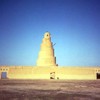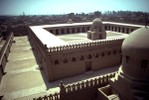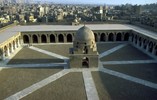Previous Lecture | Next Lecture
Concepts
The Abbasids: the second ecumenical Islamic dynasty (750-1258), were the descendants of al-`Abbas, the Prophet's uncle, hence the name.
Samarra: the new capital established by caliph al-Mu`tasim in 836 to house his growing and much-dreaded personal army of Turkish slave-warriors (mamluks) on the Tigris, 60 miles north of Baghdad. It developed into a conglomeration of secluded caliphal palaces and houses for the troops on a grandiose scale and remained capital until 883 when it was abandoned and Baghdad regained its old position.
Al-`Askar: A new garrison town established by the Abbasids in 751 north of Fustat to house their army after they had toppled the Umayyads. It was subsequently absorbed by al-Fustat which was expanding north away from the river.
Ahmad ibn-Tulun: A Turkish governor sent by the Abbasids who managed through cunning and superb organization to create a semi-independent principality in Egypt and parts of Syria. His descendants, The Tulunids, formed a dynasty that lasted for almost forty years (868-905).
Al-Qata'i` (the wards or the fiefs): The new settlement built north of Fustat around the site of the future Citadel of Cairo by Ahmad ibn-Tulun as his capital. Samarra was probably the prototype for this new settlement. The center of al-Qata'i` was occupied by Ibn Tulun's palace complex, his hippodrome, and a stately mosque that still stand today.
Baghdad: The round city founded in 762 by al-Mansur (754-75), the second Abbasid caliph, to be his royal center on the western bank of the river Tigris.
The Mosque of Ibn-Tulun: The furthest westerly evidence of the spread of the Abbasid imperial style in its decoration, its construction material, and its minaret, this mosque is perhaps the most serene structure in Cairo. It is distinguished by its brick piers with four engaged brick columns on the four sides (a combination of eastern and western influences), its angularly spiraling minaret, and its ziyadas, or open extensions which ring it on three sides and work as buffers between the streets' bustle and the religious space inside.
Monuments






